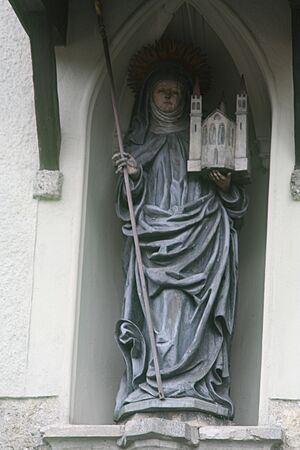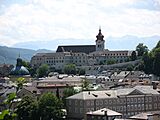Erentrude facts for kids
Quick facts for kids SaintErentrude |
|
|---|---|

Statue of Erentrude at Nonnberg Abbey
|
|
| Nun | |
| Born | late 7th century |
| Died | 30 June 718 Salzberg, Germany |
| Venerated in | |
| Feast | 30 June |
Erentrude (also known as Ehrentraud or Erendrudis) was a saint and the first abbess (leader of a convent) of Nonnberg Abbey. She was born in the late 600s, likely in what is now Germany or Austria. She came from a royal family and was the niece of Rupert of Salzburg.
Erentrude helped Rupert start religious communities in Salzburg. Around the year 700, Rupert built a convent called Nonnberg Abbey and made Erentrude its leader. She and the nuns at Nonnberg helped people who were poor, sick, and in need. They balanced their quiet life as nuns with important charity work. Erentrude passed away on June 30, 718. After her death, many stories grew about her healing miracles and how she helped people through prayer. In 2006, her image appeared on an Austrian coin. Her special day, or feast day, is celebrated on June 30.
Contents
Erentrude's Early Life and Work
Erentrude was born in the late 600s. We don't know the exact date or place, but it was probably in today's Germany or Austria. She came from a royal family. One old story says she was born and grew up in Franconia, a region in Germany.
A writer named Agnes Dunbar said Erentrude lived in Worms and "was dedicated to God from her childhood." Erentrude was the niece of Rupert of Salzburg. Much of what we know about Erentrude comes from Rupert. The first life story about her was written in the early 1300s by Caesarius. He was a chaplain at Nonnberg Abbey. He got his information from the oldest nuns and people in the area.
Erentrude received her education at the convent of St. Radegund in Poitiers, France. She entered there to become a nun. Rupert had been preaching and starting churches in Bavaria for several years. He returned to his hometown of Worms, where Erentrude was serving as an abbess. He asked for help from "devoted men and women" for his work.
Erentrude left her home to help Rupert start religious communities in Salzburg. He built a convent, Nonnberg Abbey, near Salzburg around the year 700. He made her its first abbess. Nonnberg Abbey is the oldest Benedictine women's community in what was then part of Germany. This abbey was even shown in the 1965 movie The Sound of Music.

Caesarius's writings describe the work Erentrude and her nuns did at Nonnberg. Their work went beyond just prayer. Erentrude and the nuns at Nonnberg helped the poor and the sick. This was a main part of their life as nuns. They found a good balance between helping others and their quiet life of prayer. The wealth of convents during this time was often given to poor people who came to their doors. So, the nuns were always able to help those in need. Caesarius praised Erentrude's "great love for children." She taught this to the nuns at Nonnberg. She guided her nuns and the young women under her care "with all gentleness and wisdom."
Erentrude's Death and Lasting Impact
According to Caesarius, in early 718, Saint Rupert knew he was going to die soon. He asked Erentrude to visit him. He told her he would die soon and asked her to keep praying for him. She asked if she could die before him. Rupert told her no, but she reminded him that she had left her home to follow him to Salzburg. So, he agreed to pray for her to join him after he died.
Shortly after Rupert died in March 718, Caesarius reported that Erentrude had a vision. She saw Rupert telling her it was time for her to die. She died three months after him, on June 30, 718. She was buried in a grave among the rocks at Nonnberg. After her death, Erentrude became famous for healing miracles and helping people through prayer.
Rebuilding and Relics
In the 1000s, Emperor Henry II rebuilt the church and convent at Nonnberg. They had been burned down and robbed. He did this as a "thank offering" because he was cured of leprosy. He believed Erentrude had helped him. The emperor wore a gold ring with a small piece of Erentrude's remains (a relic) in it. When he lost it, his leprosy came back. But when he rebuilt her monastery, he was cured "at once and for life."
When the church was rededicated in 1024, Erentrude's remains were moved. They were taken from her first tomb and placed with "great honor and reverence" into the new church's crypt (an underground room). Her relics have been there ever since.
On September 4, 1624, Erentrude's remains were placed in a silver container called a reliquary. This reliquary was put under an altar in the church at Nonnberg.
Modern Recognition
In 2006, Erentrude's image appeared on an Austrian coin. The back of the coin shows the crypt dedicated to Erentrude in Nonnberg Abbey, with her statue. Her feast day is celebrated on June 30.
Saint Erentrude also appeared on an Austrian postage stamp in 2018.

